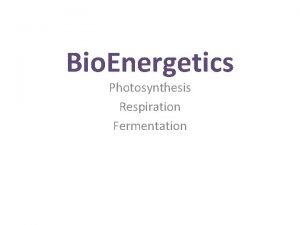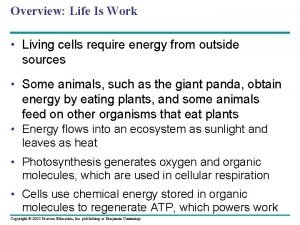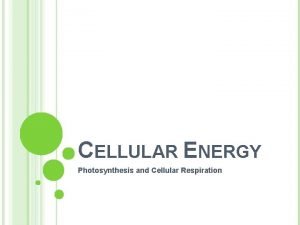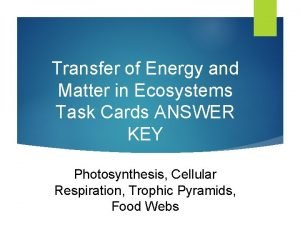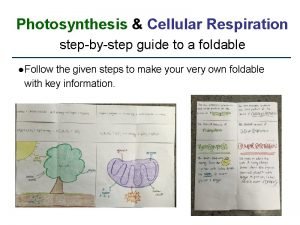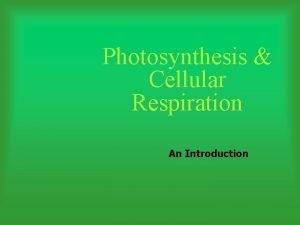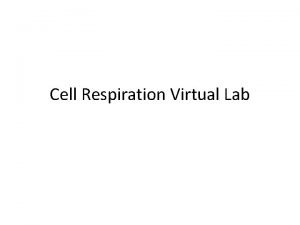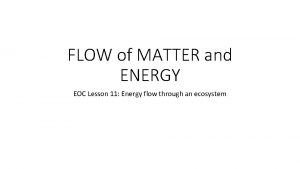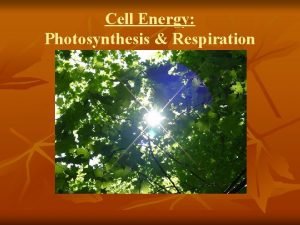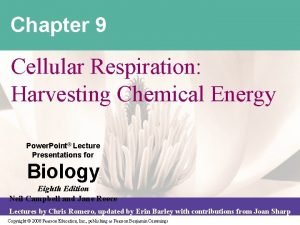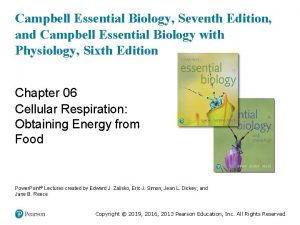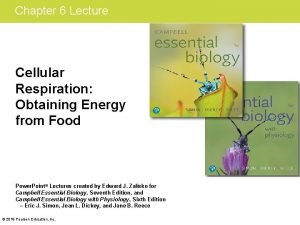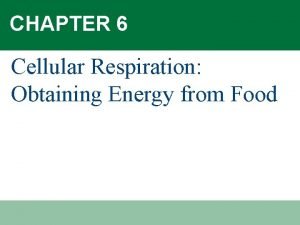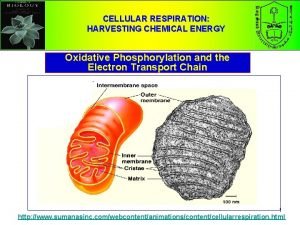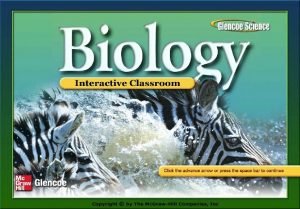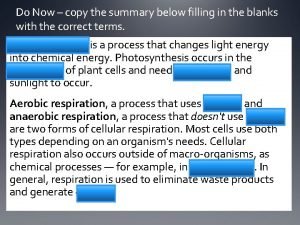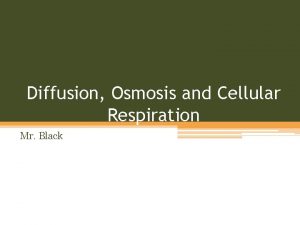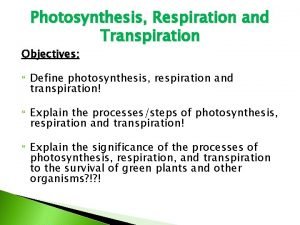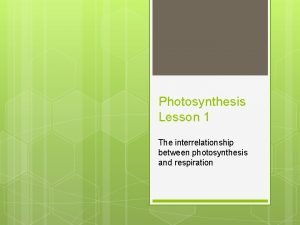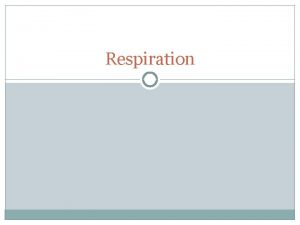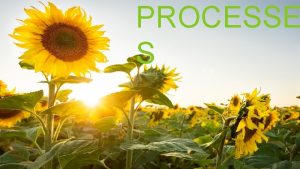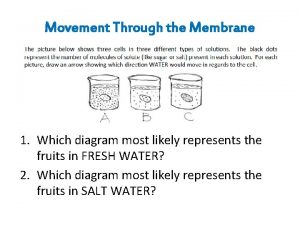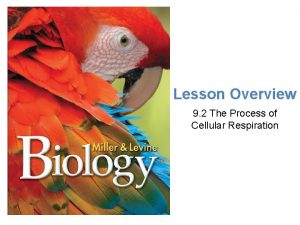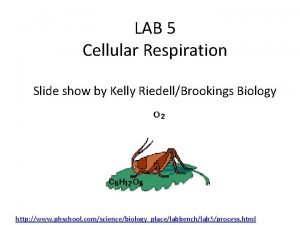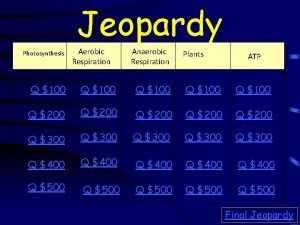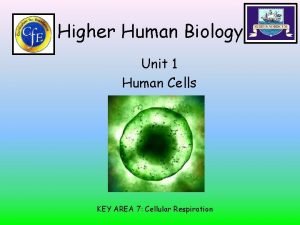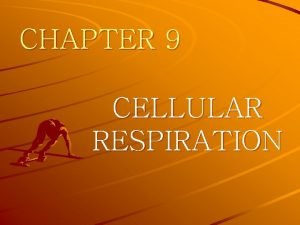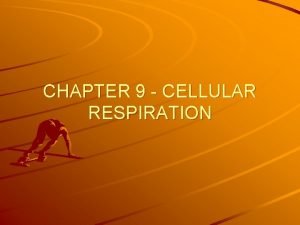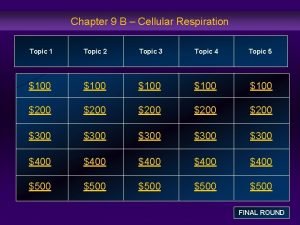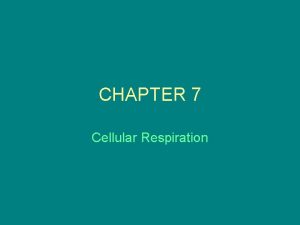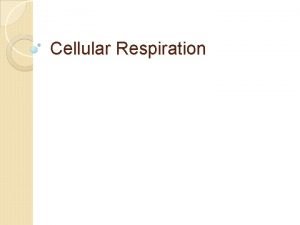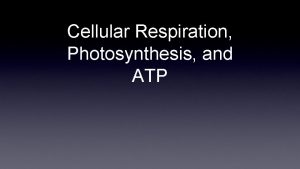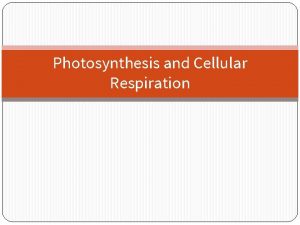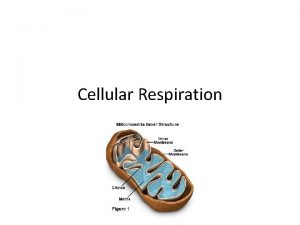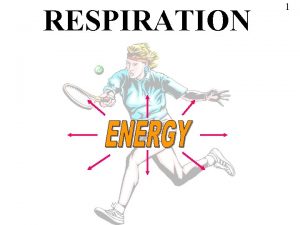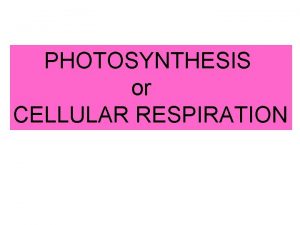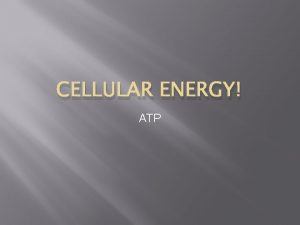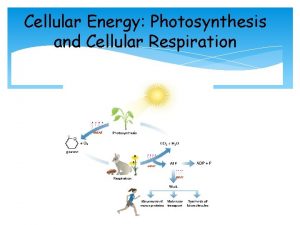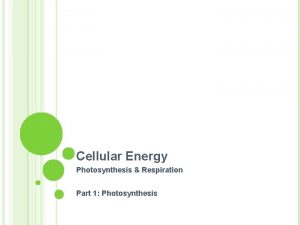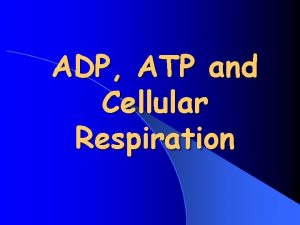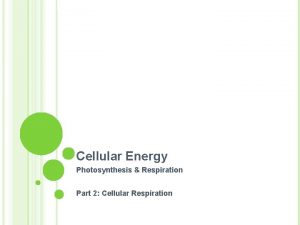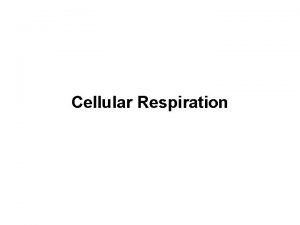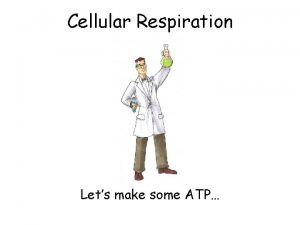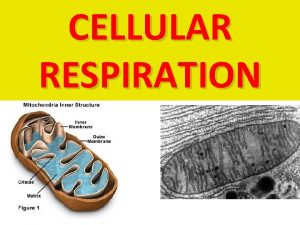ENERGY ATP PHOTOSYNTHESIS and CELLULAR RESPIRATION Energy is


















































- Slides: 50

ENERGY ATP PHOTOSYNTHESIS and CELLULAR RESPIRATION

Energy is the ability to ______or_____. cause change do work Nearly every activity in modern society depends upon energy.

All living things need energy. bacteria plants animals protists fungi

Our bodies Why douse youenergy need energy? to do work. movement Temperature control growth Active transport

Can we use the sun’s energy to do this work? NO!!! Which organisms can use the sun’s energy? PLANTS and ALGAE Plants and algae absorb sunlight and make food…. glucose.

How do we(animals) obtain energy? Animals must eat/consume food…. they must consume plants or other animals.

The flow of energy in living systems: sun leaf Sunlight Energy source Absorbs sunlight Makes glucose/food Stored chemical energy caterpillar bird Consumes food Stored energy

energy The sun is the ultimate source of______. All living things on Earth depend on the Sun for energy … directly in indirectly.

Energy from the sun enters living systems plants and algae when _________ absorb sunlight.

The energy in sunlight is captured and used to make ______. . . _________. food carbohydrates gluc ose

Glucose has stored chemical energy . . . energy stored in chemical bonds.

Ultimately, nearly all life on Earth depends on the ability of autotrophs (plants and algae) to capture the energy in sunlight and store it in molecules of glucose/carbohydrates.

Photosynthesis is the process that converts light energy from the sun into chemical energy stored in the chemical bonds of sugars. . . carbohydrates. . . glucose. sun CO 2 H 2 O Glucose C 6 H 12 O 6 O 2

Photosynthesis light energy + 6 CO 2 sunlight Carbon dioxide + 6 H 2 O water C 6 H 12 O 6 + glucose 6 O 2 oxygen Photosynthesis also produces oxygen.

The oxygen in our lovely atmosphere is the result of photosynthesis.

organelle does photosynthesis take place? In which Photosynthesis takes place in the chloroplasts of plant cells and algae. Plant cell Chloroplast

Chlorophyll is the pigment that absorbs sunlight during photosynthesis. Chlorophyll gives leaves their green color.

Autotrophs are organisms that use energy from sunlight to make food. . . carbohydrates. Autotrophs are organisms that make their own food. Autotrophs are producers. glucose

Examples of autotrophs : Some bacteria algae Some protists plants

Some organisms eat plants, obtaining energy from the stored glucose in the plant. Some animals eat other animals.

Heterotrophs are organisms that must get energy from food instead of directly from the sun. Animals Heterotrophs cannot make their own food, they must consume food. Heterotrophs are consumers. F U N G I Examples?

Animal-like protists Bacteria

Heterotrophs obtain energy from the food they eat. But how?

How does a car move? Gasoline is the fuel that powers the car.

Food is the fuel that powers our bodies.

What are the foods you eat composed of? macromolecules : The foods you eat are composed of ________ carbohydrates lipids proteins. All these macromolecules contain _______. stored chemical energy

The macromolecules in food must be broken down - - - digestion.

glucose glucose glu co se ose c glu Starch is broken down into molecules of glucoses se e cos Starch = chain of glucose co glu In animals, food must first be broken down into simple molecules like glucose. glu

glucose glucose glu co se e cos Glucose travels to all cells in the body. glu Glucose diffuses into the blood vessels. gluc ose glucose

Glucose enters a cell and moves into the mitochondria. glucose

In the mitochondria, glucose is broken down and energy is produced. ATP glucose

Making energy…. that’s cellular respiration! ATP glucose

Cells obtain energy from food through the process of cellular respiration. Cellular respiration is a process by which food (glucose) is broken down to produce energy - - - ATP 6 Carbon 1 Carbon C 6 H 12 O 6 + 6 O 2 6 CO 2 + 6 H 2 O + ATP (glucose) (oxygen) carbon (water) (energy) dioxide

Cellular respiration complex process in which cells make ATP by breaking down glucose. GLUCOSE occurs in the mighty mitochondria broken down ATP Makes energy for the cell

ATP is the energy molecule. ATP powers the cell. ATP

Why do we need oxygen? To break down glucose for energy!!!!! For cellular respiration!!!! Aerobic Cellular Respiration: requires oxygen C 6 H 12 O 6 + O 2 CO 2 + H 2 O + ATP (glucose) (oxygen) carbon (water) (energy) dioxide

Why do you feel a burning pain in your muscles when you work out hard? Because of lactic acid built up

During intensive exercise, your blood can not carry oxygen to your muscles fast enough. Without oxygen, your muscle cells cannot do aerobic cellular respiration …. . instead they do anaerobic cellular respiration. Muscle cells break down glucose without oxygen. Glucose breaks down into lactic acid. Anaerobic Cellular Respiration. . . without O 2

Anaerobic Cellular Respiration glucose alcohol + CO 2 + Production of wine: Yeast convert the sugars in grapes into ethyl alcohol. Grapes fermenting ATP

Do plants do cellular respiration too? YES!!! All living things need energy!!

Both autotrophs and heterotrophs undergo cellular respiration. Plants break down glucose for energy Plant cells have mitochondria Animals break down glucose for energy Animal cells have mitochondria

But plants are special because…. . Plants can make their own glucose!

Plants make glucose in the _______. chloroplasts glucose

Plants also break down glucose for energy (ATP) in the _______ mitochondria ATP glucose

Plants take in water through their roots. How do plants take in CO 2?

Plants have small openings(stomata) on the underside of leaves.

CO 2 enters thru these openings(stomata) and O 2 exits Gas exchange occurs through these openings (stomata).

Do the stomata stay open all the time for maximum photosynthesis? No, or else the plant would lose a lot of water vapor and dry up.

Guard cells open and close the stomata to control water loss while allowing a good rate of photosynthesis.

 Formula photosynthesis
Formula photosynthesis What is the difference between autotroph and heterotroph
What is the difference between autotroph and heterotroph Total atp produced in cellular respiration
Total atp produced in cellular respiration Cellular respiration
Cellular respiration Complementary processes
Complementary processes Formula for celluar respiration
Formula for celluar respiration Function of cellular respiration
Function of cellular respiration Where does cellular respiration take place
Where does cellular respiration take place Photosynthesis and cellular respiration foldable
Photosynthesis and cellular respiration foldable Edpuzzle photosynthesis and cellular respiration
Edpuzzle photosynthesis and cellular respiration Photosynthesis and cellular respiration
Photosynthesis and cellular respiration Cell respiration virtual lab
Cell respiration virtual lab Photosynthesis and cellular respiration jeopardy
Photosynthesis and cellular respiration jeopardy Photosynthesis or cellular respiration
Photosynthesis or cellular respiration Chapter 6 cell energy photosynthesis and respiration
Chapter 6 cell energy photosynthesis and respiration The stages of cellular respiration
The stages of cellular respiration Energy flow in cellular respiration
Energy flow in cellular respiration Chemical cycling in an ecosystem
Chemical cycling in an ecosystem Explain how amp stimulates cellular respiration
Explain how amp stimulates cellular respiration Chapter 9: cellular respiration: harvesting chemical energy
Chapter 9: cellular respiration: harvesting chemical energy Cellular respiration obtaining energy from food
Cellular respiration obtaining energy from food Cellular respiration obtaining energy from food
Cellular respiration obtaining energy from food Cellular respiration harvesting chemical energy
Cellular respiration harvesting chemical energy Chapter 8 section 2: photosynthesis
Chapter 8 section 2: photosynthesis Flocabulary photosynthesis read and respond answers
Flocabulary photosynthesis read and respond answers Venn diagram photosynthesis and respiration
Venn diagram photosynthesis and respiration The warm up osmosis
The warm up osmosis Photosynthesis define
Photosynthesis define Interrelationship between photosynthesis and respiration
Interrelationship between photosynthesis and respiration Cellular respiration redox
Cellular respiration redox What is the correct equation for cellular respiration?
What is the correct equation for cellular respiration? Cellular respiration steps
Cellular respiration steps Aerobic vs anaerobic
Aerobic vs anaerobic Fermentieren bedeutung
Fermentieren bedeutung Why is cellular respiration important
Why is cellular respiration important What's the equation for cellular respiration
What's the equation for cellular respiration Amloplast
Amloplast Starting materials for cellular respiration
Starting materials for cellular respiration Electron carriers in cellular respiration
Electron carriers in cellular respiration Overview of cellular respiration
Overview of cellular respiration Aerobic respiration overview
Aerobic respiration overview Cellular respiration
Cellular respiration Lab bench cellular respiration
Lab bench cellular respiration What is the word equation for cellular respiration
What is the word equation for cellular respiration Higher human biology cellular respiration
Higher human biology cellular respiration Cellular respiration product
Cellular respiration product Cellular respiration releases
Cellular respiration releases Starting materials for cellular respiration
Starting materials for cellular respiration Chapter 8 section 3 cellular respiration
Chapter 8 section 3 cellular respiration Redox reaction in cellular respiration
Redox reaction in cellular respiration Where in the cell does cellular respiration occur
Where in the cell does cellular respiration occur

